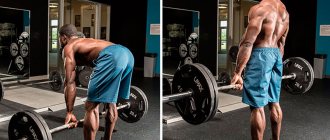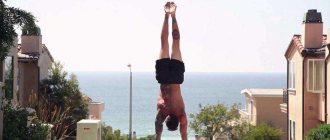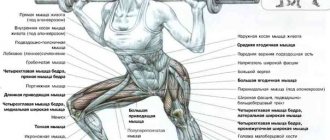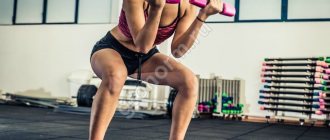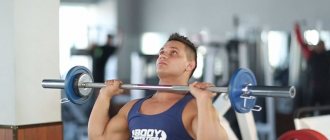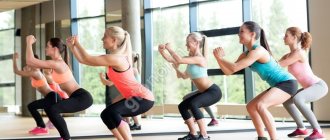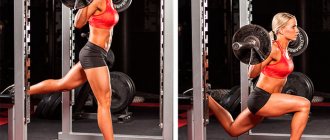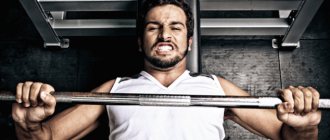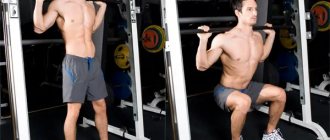Do you want to pump up your thighs and buttocks, but don’t have the energy or time to go to the gym after work? This can be done at home too. To do this, you need to regularly perform squats on one leg. The “pistol”, as it is also called, in its effect on the muscles of the buttocks and legs is equivalent to squats with a barbell. Significant differences between these exercises will be the absence of additional weight-load, working only with your own body, and the ability to train in any convenient place. Today we will tell you how to do squats on one leg.
Single Leg Squats: Pros and Cons
Single leg squats are a strength training exercise that was used by old school strongmen. The movement has become popular again thanks to CrossFit, where it is used as one of the gymnastic elements. The main benefit of the pistol squat is that the entire load falls on one leg. This allows you to provide a powerful load even when working without weights.
Benefits of single leg squats:
- A powerful load on the buttocks, quadriceps and hamstrings.
- Involvement of a large number of muscle fibers (including stabilizer muscles).
- Development of balance.
- There is a complete absence of compression load on the spine, which is why the movement is excellent for gaining weight for people with injuries.
- The ability to perform the exercise in any conditions and without sports equipment.
Main disadvantages:
- They require certain physical preparation and are not suitable for beginners (muscles often do not allow for full squats on one leg).
- Creates increased stress on the knee joint.
- The risks of injury are higher than with other leg exercises.
Standing lifting technique
You can do calf raises while standing using the Smith machine, Hack machine, as well as with free weights - barbell, dumbbells, sandbags, kettlebells.
With a barbell
An option for those who know how to stabilize the core and hold the weight correctly when deadlifting. If you don’t have such a skill, it’s worth learning, but in the meantime, do exercises for your lower legs in simulators.
In fact, there are two options with a barbell - with the barbell on your back and in straight, outstretched arms.
In straight outstretched arms the technique is as follows:
- Stand up straight, raise the weight to the level of your pockets by extending the hip and knee joints, keep the weight slightly wider than your hips;
- Then place the socks on supports or pancakes;
- Perform the required number of lifts with a natural movement, as if standing on tiptoes;
- Get off the support;
- Lower the bar to the floor
Standing Barbell Calf Raise with Deadlift Hold
If it is not possible to hold the working weight with a direct grip or a “lock”, you can perform a variation of the exercise when the working weight is taken on the back, as in a squat. You need to set the bar at a height accessible for squatting, place your palms slightly wider than your shoulders, step up, bend your legs at the knee joints and in one motion remove the bar from the racks, move away from them, and place your toes on the plates. Then the required number of repetitions is performed, and the apparatus is returned to the racks.
With dumbbells
This option is easier for those who have problems maintaining balance and stabilizing their core muscles.
The option with dumbbells is done like this:
- Stand up straight, lift the dumbbells from the floor in one movement, like in a deadlift;
- Place them on the sides, the bars parallel to each other;
- Complete all reps of lifts;
- Remove socks from the plates, step away, put the dumbbells on the floor
The one-leg option with one dumbbell or plate, and holding a vertical support (wall or exercise machine) with your free hand, is good for creating symmetrical calves if a person has scoliosis, as well as for diversifying the training.
In the gym
A common advantage of all exercise machines is the ability to perform exercises more isolated, without “returning” excess load to the core muscles.
The technique is like this:
- Place weights on your back or shoulders;
- Remove the safety stop of the simulator;
- Place your socks so that it is comfortable to climb;
- Perform the required number of lifts;
- Place the weight in place and secure the safety stop
Standing calf raise
What muscles work
Single leg squats work almost all the muscles in your legs. The main burden falls on:
- Quadriceps.
- Gluteal (mostly large).
- Biceps femoris.
- Calf muscles.
- Leading.
Also, work in static mode , which stabilize the body.
Uses, features and advantages
Like any exercise, single leg squats have pros and cons. The negative aspects of training and contraindications to it will be described further in the text. Now we want to describe the advantages and benefits that an athlete who performs this element receives.
Squats on one leg provide the following advantages:
- coordination of movements, stability, flexibility, endurance, concentration increases, neuromuscular connections improve;
- muscles and ligaments that are not used in other exercises are worked out;
- the load on the back muscles is reduced, since the main “impact” falls on the legs;
- the main load falls on the quadriceps;
- The ligaments are strengthened, the strength and volume of the leg muscles, especially the thighs, increases.
An additional advantage of this exercise is its versatility. If you successfully squat without using supports, you can do it in the gym, at home, on the street, in the subway, even while standing at a bus stop.
Technique for performing the pistol exercise at a support
To master the movement safely, it is best to start working with support. It will allow you to fix the position of the body and avoid falling in case of loss of balance or muscle fatigue. It is extremely important that the support is stable.
Technique:
- Stand at a support and grab it with your hand. The back is straight, feet shoulder-width apart.
- Begin to bend your right leg, slowly lowering yourself down. Gradually move your left leg forward without touching the floor.
- Pause for 0.5 seconds and return to the starting position in the same order.
When performing it, it is important to ensure that the force is performed with the leg and not the arm. In this case, the benefit of the pistol will be noticeable.
Pistol squats - exercise technique
So, you are ready to proceed directly to the exercise itself (as in the video at the end of the article). Let's look at the technology and features in more detail.
- Let's stand up straight. Feet are slightly narrower than shoulder width, arms extended forward or to the sides.
- We inhale and slowly lower ourselves as far as possible. At first, paralleling the thigh with the floor is enough, then you should sit down completely.
- At the same time, the back can bend strongly as we stretch forward so as not to fall. In this version of squats, this is not scary, since we do not have excess load on the back.
- As with any other squats, we try not to bring the knee past the toe.
- At the lowest point, we linger for a couple of seconds, tense our muscles and, with an exhalation, push ourselves to the starting position. The emphasis is always on the heel.
- After that we change the leg.
Pistol squats
Do not put your weight on the forefoot, the emphasis should be on the heel
Start with a few squats and gradually increase the number to 8-10 times on each leg.
Over time, athletes are looking for more and more difficult ways to test themselves, but we do not recommend doing this without a high level of training.
Remember that even with good training this can be dangerous
Video: Single leg squats
Technique for performing squats on one leg without support
This is a classic version of a 1-leg squat that does not require support.
Technique:
- Stand straight with your feet shoulder-width apart.
- Begin to lower yourself slowly, bending one leg at the knee.
- You can cross your arms over your chest or put them forward if this helps you maintain your balance.
- Place your other leg forward so that it does not touch the floor.
It is also important to do the pistol with a straight back. Without support, especially if additional weights are used, the back may become round. A slight bend in the back is acceptable, but only the upper part of the body does not “fall” forward.
Why don't my buttocks hurt after squats?
It is necessary to practice the correct squat, when the load is distributed evenly across all muscles. Control the position of your feet - they should be shoulder-width apart or wider than shoulder-width apart, depending on the specific exercise. When squatting, press your heels tightly to the floor - then the load will go to the gluteal muscles.
If after exercise your butt starts to “burn”, this is neither good nor bad, it just means that you overdid it a little with the load. There is a common myth that body pain after exercise is a good sign. In fact, pain is simply microtrauma of muscle fibers, and it has little to do with efficiency.
To summarize, it can be argued that squats for elastic buttocks contribute to the loss of a large number of calories, acceleration of metabolism, and increase in heart rate. At the same time, fat is burned and muscle mass is actively formed. The buttocks become strong and elastic. The exercises tighten the hips and remove the “breeches” that many women constantly struggle with. Legs become slender and beautiful.
Good luck to you and achieving your goal!
Stand straight, bring your legs together, stretch your arms forward, palms down. Bend your knees and lower yourself down until your buttocks touch your heels. During this exercise, your heels will involuntarily lift off the ground, and your knees will move forward far beyond the level of your toes.
You are doing everything right! At the lowest point, lower your hands to the floor, slightly supporting yourself. Return to the starting position.
Smith Single Leg Squats
The Smith Single Leg Drop is the only exercise where it is safe to use heavy weights. This version is also good for beginners (with an empty bar) or athletes who have poor balance.
Technique:
- Place the bar on your shoulders and stand straight with your feet shoulder-width apart. The body should fall down perpendicular to the floor and without tilting.
- Begin to sit down, bending one leg at the elbow. Pull the second one forward, as in a regular pistol.
- Without pausing, return to the starting position at a moderate pace.
Taking into account the load on the back, the main difference from techniques without weight and support is the position of the back. If in classic versions a slight rounding of the back is allowed, then when lifting weights on the shoulders this will be considered a mistake.
Lead-up exercises
Only a few athletes can immediately perform a squat on one leg without support. The vast majority of people, even if they can sit down, will certainly not be able to stand up. And the point is not always the weakness of your muscles, but mostly the unfamiliarity of the load.
So, what exercises can you do to prepare your muscles for performing pistols:
- Stand with your feet shoulder-width apart. Raise your straight leg until it is parallel to the floor and try to stand in this position for at least 30 seconds. This is not the easiest task.
- Next, practice squatting on one leg without raising the other in front of you. To do this, you will need a sturdy stand or box. Place the box near a wall or other support. Holding the support with your hands, squat on one leg, freely lowering the other down.
- The next step is to perform pistols while holding the support with your hands. That is, we squat on one leg, bringing the other forward, but at the same time supporting ourselves with one or two hands. In particular, you can perform the exercise by opening the door and holding its handles on both sides with your hands. When squatting, the door is located between the legs. The main thing is that the door fastening is strong enough.
- Make it more difficult. Now you squat without holding it with your hands, but simply touching the support with your shoulder. Stretch your arms forward. The benefit of such touching the support is rather psychological. In fact, this is already a full squat on one leg.
In addition to the above exercises, classic squats with a barbell, dumbbells or other weight will help you gain overall leg strength. You can perform single-leg squats on a Smith machine. In this case, there is no need to maintain balance, which simplifies the task.
Be sure to include some leg stretching exercises in your workout plan. Without sufficient flexibility, it will not be possible to perform the exercise correctly.
With strict adherence to these recommendations and regular training, you will receive well-developed leg muscles and toned buttocks as a reward for your efforts. The main thing is to remember about the impact on your knees, and if the slightest discomfort occurs, reduce the load.
Free weight option
Of the free weights, the most convenient equipment is the kettlebell. You can press it to your chest without losing your balance. A dumbbell is also suitable for this, but due to its shape, holding it becomes less comfortable.
Features of working with different projectiles:
- Kettlebell – you can use very large weights, hold it comfortably (with your palms on the sides of the apparatus), and do not interfere with balance. The only negative is that it is difficult to regulate the step in increasing weight. 20 exercises with kettlebells →
- A dumbbell is a less convenient option, but allows you to adjust the step by 1-2 kg, which simplifies the progression of the load. Exercises with dumbbells here →
- Sandbag is a good option due to the “streamlined” nature of the bag. Allows you to evenly distribute weight on your shoulders and perform movements without losing balance. The best choice for working with very heavy weights. Read more about what sandbag is →
- The barbell disc is convenient because it can be held with outstretched arms, which helps maintain balance. However, in this position, the shoulder and abdominal muscles are more heavily loaded. And also read: exercises with a barbell disc →
The weight of the equipment must be selected so that a set of 6-8 repetitions can be performed on each leg. Performing more than 10 repetitions per leg is considered less effective, since it does not provide tangible benefits, but puts much more strain on the knee joint.
How to learn to do a pistol: introduction exercises
The main way to learn the pistol squat is to perform the movement using a simplified technique. This allows you to get used to the motor pattern of the exercise and gradually strengthen the muscles.
Leading exercises and techniques:
- Air squats or weighted squats.
- Partial squats on one leg while holding the support (in a shortened amplitude).
- Supported squats slowing down for 2 seconds at the bottom.
- Full squats while holding support.
Execution options
- Movement in TRX loops . It’s easier to learn how to make a pistol if you maintain balance using loops. They need to be attached to a support and held with your hands so that they are stretched. This will help contract the back muscles and prevent the body from falling forward. Loop squats help beginners understand the mechanics of a one-leg squat and simultaneously pump up their back muscles;
- Squat on one leg from a support . The supporting leg is placed on a step platform or plates; the movement is simpler in that you do not need to stretch your leg forward, you can simply “hang” it slightly down;
- Squat on one leg with support on the toes . This option is for complete beginners who do not have a platform or pancakes at their disposal and have problems with coordination. It is necessary to carefully deweight the free leg so that the movement is active, but the leg does not rest on the floor. It is used only as a last resort for balance. And the working leg bends at the knee and hip joints as usual.
Single leg squats: 2 options
Recommendations
- Never do a movement at the beginning of a workout. To safely perform pistol training, warming up alone may not be enough, so it is better to do it after other exercises.
- The multi-repetition mode should only be used when working without weights.
- To progress, it is enough to perform 3-5 approaches per week.
- The number of movements on each leg should be the same.
When working with weights, increased stress is placed on the back, especially the lower back. Therefore, before performing it, it is recommended to do 1-2 warm-up sets of hyperextension.
